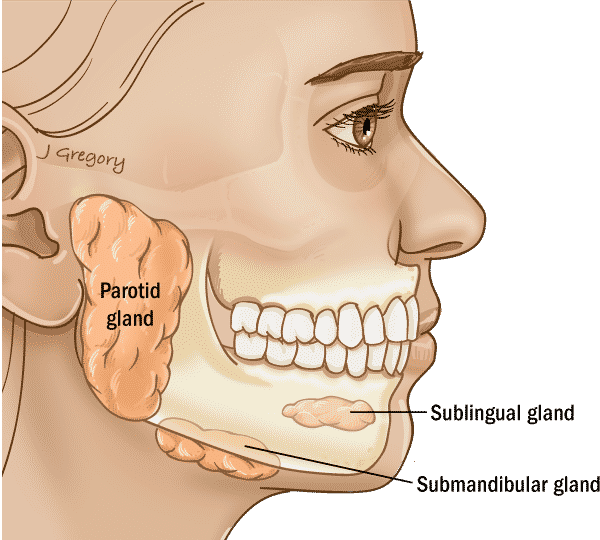Type
The best way to classify neck cancers is to determine if it is a cancer that started in the neck, or if it has spread from another site. If the cancer started in the neck, it is called a primary neck cancer. There are several different possible types of primary neck cancers.
Sarcomas
A sarcoma is cancer in the neck that arises from soft tissue such as bone, cartilage, muscle, or fat. One example is rhabdomyosarcoma.
Rhabdomyosarcoma
This is the most common soft tissue cancer of childhood (soft tissue cancers do not include blood-based cancers such as lymphoma). The most common site for rhabdomyosarcoma is the orbit (eye), but they can be found just about anywhere in the head and neck region (and even other parts of the body). There are several subtypes of rhabdomyosarcoma, including embryonal, alveolar and pleomorphic. The main treatment for rhabdomyosarcoma is chemotherapy, but other methods such as surgery and radiation may play a role in select cases.
Additional types of sarcomas, according to the World Health Organization classification
- Adipocytic Tumors
- Atypical lipomatous tumor/well-differentiated liposarcoma
- Dedifferentiated liposarcoma
- Myxoid liposarcoma
- Round cell liposarcoma
- Pleomorphic liposarcoma
- Mixed-type liposarcoma
- Liposarcoma, not otherwise specified
- Fibroblastic/Myofibroblastic Tumors
- Low-grade myofibroblastic sarcoma
- Myxoinflammatory fibroblastic sarcoma
- Infantile fibrosarcoma
- Adult fibrosarcoma
- Myxofibrosarcoma
- Low grade fibromyxoid sarcoma hyalinizing spindle cell tumor
- Sclerosing epithelioid fibrosarcoma
- So-called Fibrohistiocytic Tumors
- Undifferentiated pleomorphic sarcoma/malignant fibrous histiocytoma
- Undifferentiated pleomorphic sarcoma/Giant cell malignant fibrous histiocytoma
- Undifferentiated pleomorphic sarcoma with prominent inflammation/Inflammatory malignant fibrous histiocytoma
- Smooth Muscle Tumors
- Leiomyosarcoma (excluding skin)
- Skeletal Muscle Tumors
- Embryonal rhabdomyosarcoma (including: spindle cell, botryoid, anaplastic)
- Alveolar rhabdomyosarcoma (including: solid, anaplastic)
- Pleomorphic rhabdomyosarcoma
- Vascular Tumors
- Angiosarcoma of soft tissue
- Kaposi’s sarcoma
Lymphomas
Lymphoma is a cancer of the lymphatic system in the body. Lymphoma is the most common neck cancer in children and is frequently seen in adults as well. Lymphomas can be broken down into non-Hodgkin lymphoma and Hodgkin lymphoma. These two types behave very differently in terms of epidemiology and survival. Surgery may be necessary to diagnose a lymphoma, but treatment typically involves either radiation or chemotherapy.
- Non-Hodgkin Lymphoma
This describes about 30 different types of lymphomas, and generally occurs in the lymph nodes. Treatment typically consists of a chemotherapy regimen. One of the rarer forms of non-Hodgkin lymphoma is found within mucosa-associated lymphoid tissue (MALT), which are small concentrations of lymphoid tissue that exist in the mucosa of the lungs, stomach, intestines, and the outer lining of the eyes. - Hodgkin Lymphoma
This type of lymphoma typically presents in teenagers or young adults (aged 15 to 34), or in people over the age of 55. It is a cancer of the lymphoid cells, and it is spread via adjacent lymph node regions. Staging for Hodgkin lymphoma is based on which regions of the body contain the cancerous lymph nodes or bone marrow (see the Stage section below). The chances of a successful cure are generally high. There are a few different subtypes of Hodgkin lymphoma based on World Health Organization (WHO) criteria:- Nodular lymphocyte predominance
- Nodular sclerosing
- Mixed cellularity
- Lymphocyte depletion
Other Cancers That Can Spread to the Neck
Salivary Gland Cancer
Some salivary glands are located in or near the neck, such that a salivary gland cancer could present as a neck mass. For example, the submandibular gland is located in the neck, and a submandibular gland cancer often presents as a neck mass just under the jawbone. Additionally, the ‘tail’ of the parotid salivary gland is located in the upper portion of the neck, so a parotid cancer could also present as a neck mass. Metastatic lymph node containing salivary gland cancers also commonly appear in the neck. See Salivary Gland Cancer and Metastatic Lymph Nodes to read more about these cancers.

Skin Cancers
Since the neck is covered with skin, skin cancers can appear as neck cancers as well. This is particularly important because the neck is often exposed to the sun, which is a major cause of skin cancer. See Skin Cancers to learn more.
Aggressive Benign Tumors
There are a few types of benign (non-cancerous) tumors that may be found in the neck, and that can behave aggressively. These tumors are usually treated with surgery, but in some cases, radiation or chemotherapy may be warranted. For example, desmoid tumors, paragangliomas, vascular malformations, and hemangiomas are all aggressive benign tumors that may removed or otherwise treated to prevent further growth.
Grade
A doctor will rely on the final pathology of the tumor to determine the grade and stage of the cancer. The grade is usually only determined after the tumor has been surgically removed.
Sarcomas are given a grade based on tumor characteristics seen under the microscope. There is a three-tiered system that is based on a number of factors, including differentiation, mitotic activity, and necrosis. Learn more about these pathologic features.
Each pathologic feature is given a score of 1 to 3, and the scores are tallied for a final grade:
Score Grade Cannot be evaluated GX Total score of 2 or 3 G1 Total score of 4 or 5 G2 Total score of 6 to 8 G3 and G4
Learn more about the grading systems for salivary gland cancer and skin cancer.
Stage
The stage of a cancer is determined by the TNM staging system:
- The ‘T’ stands for tumor size.
- The ‘N’ stands for lymph node involvement.
- The ‘M’ stands for distant metastases, or cancer spread to other areas of the body.
Staging helps doctors determine how serious the cancer is and how best to treat it. Staging systems often reference very specific anatomical structures. Please reference the anatomy page to learn more about these terms.
The staging systems for sarcomas and lymphomas are discussed below.
Read more about the staging systems for salivary gland cancer and skin cancer.
Sarcoma Staging
Currently, the 8th edition of the American Joint Committee on Cancer (AJCC) Staging System does not have a formal staging system for head and neck sarcomas due to a lack of data. TNM definitions can be found in the TNM Staging Tool below, but no formal stages are defined.
Lymphoma Staging
Lymphomas have their own staging system based on what parts of the body are involved by the cancer. Today, imaging and diagnostic tests have greatly reduced the need for abdominal surgeries to obtain tumor biopsies. Therefore, the staging of lymphomas is clinical, meaning that doctors will use information from physical exams and imaging to decide how involved the cancer is before starting treatment.
The illustration below helps describe the staging for lymphoma. The red curved line represents the diaphragm, a sheet of muscle that separates the thorax from the abdomen. Whether cancerous lymph nodes are on both sides of the diaphragm, or on just one side, plays an important role in the staging of lymphoma. See the chart following the illustration for an explanation of how the staging for lymphoma works.
Staging for Lymphoma
| Stage I | Only a single lymph node region or a single extralymphatic organ is involved. |
| Stage II | Two or more lymph node groups are involved, but they are on the same side of the diaphragm (all above or all below). |
| Stage III | Lymph node groups both above and below the diaphragm are involved. Or, involved lymph nodes above the diaphragm and spleen involvement. |
| Stage IV | More than one extralymphatic organ is involved with or without lymph node involvement. |
“Lymph node regions” include specific nodal regions (such as the neck, armpits, etc.), thymus, spleen, and Waldeyer’s ring (meaning the tonsils/adenoids/and lingual tonsil complex).
“Extralymphatic organs” include the liver, bone, brain, spinal cord or even bone marrow. Involvement of one of these organs is based on the doctor’s examination or on imaging. Biopsies of different regions may be necessary if the diagnosis is unclear, or if biopsy results could affect the treatment plan.
For lymphoma, in addition to a stage, a class will also be assigned:
- Class A is when there are no symptoms associated with the lymphoma.
- Class B is when there are symptoms associated with lymphoma, such as fevers, night sweats and weight loss.












